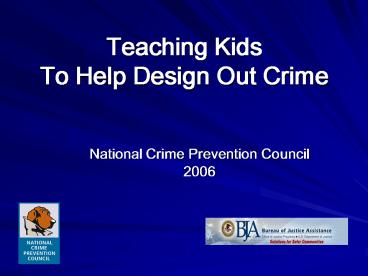Teaching Kids To Help Design Out Crime PowerPoint PPT Presentation
1 / 26
Title: Teaching Kids To Help Design Out Crime
1
Teaching Kids To Help Design Out Crime
- National Crime Prevention Council2006
2
Welcome and Introduction
3
Who are you?
- Where are you from? What is your background?
- Why are you here?
4
Objectives
- Learn the definition of CPTED
- Understand the four key CPTED principles
- Learn how children and youth can be involved in
CPTED - Identify the strengths of youth-adult
partnerships - Learn CPTED activities for your community
- Learn CPTED teaching strategies
5
What is Crime Prevention Through Environmental
Design (CPTED)?
6
Formal Definition
- Crime Prevention Through Environmental Design
(CPTED) is the proper design of the physical
environment to reduce fear and the incidence of
crime and improve the quality of life.
7
Simply put
- CPTED is using common sense to design and build
an area so it feels safe and is safe. - When CPTED principles are applied, people who use
an area feel safer and would-be criminals are
discouraged from committing crime.
8
Visioning Experience
9
Two Scenarios
- Imagine a safe community.
- Imagine an unsafe community.
10
In order for a criminal to commit a crime
- the following three factors are necessary
- The desire to commit the crime
- The ability to do it
- The opportunity to do it
11
By using CPTED strategies, we can start to
design out crime
- by modifying
- Manmade features
- Natural features
12
Four Key Principles of CPTED
- Access control (coming and going)
- Surveillance (keeping watch)
- Territoriality and maintenance (showing we care
and watching everywhere) - Activity support (having fun, studying, reading,
walking)
13
Access Control
- Natural Access Control describes how people get
into and out of an area in order to keep would-be
criminals out of the area. - Use barriers such as entrances, exits, fences,
and landscape to prevent people from entering
private or dangerous areas. - Know who is currently in a building or other
space.
14
Surveillance
- Natural surveillance strategies provide people
with ways to watch an area. - Remove hiding places, add lighting or benches,
trim bushes, and bring more people to the area so
that it can be easily seen and protected.
15
Territoriality and Maintenance
- Territoriality and maintenance are ways that
people show that they own or care for an area. - Mark clear boundaries with such things as fences,
art, signs, and landscaping. - The way we say this is our space and we care
about it and who uses it.
16
Activity Support
- Activity support promotes positive and
appropriate events and behavior in an area. - Play in a park, eat in a restaurant, park
vehicles in a parking lot. - Have a clear idea of how space
- should be used to enable planners to decide
what to put there. - Remember, the way an area is used depends on what
is in that area.
17
What can kids do?
Children and youth can contribute to CPTED
efforts.
- Children and youth have insider information.
- Children and youth have a desire to help out and
volunteer. - Young people have the skills to do what needs to
be done and can design and lead elements of
community safety projects. - Children and youth can reach their peers.
18
Who is walking the streets, playing in the parks,
and using community facilities?
- Children and Youth
19
What are the benefits of youth and adults working
together?
- They learn new things about each other.
- Each group contributes its own skills and
knowledge base. - More ideas lead to better results.
- It creates a dialog between children and adults
about safe and unsafe places in the community.
20
- Involvement Ownership
21
How To Involve Children and Youth in CPTED
- Share the following ideas for involving young
people in CPTED-based safety efforts in your
community - Create a drawing exercise to teach about CPTED.
- Conduct a walk-around safety search.
- Join forces with Neighborhood Watch groups.
- Create a check-in desk at a community center.
- Petition for better lighting in a park or
playground.
22
McGruffs CPTED Library
- Designing Safe Spaces Involving Children and
Youth in Crime Prevention Through Environmental
Design - How To Help McGruff! Service Projects for
Children To Make Communities Safer - Designing Safer Communities A Crime Prevention
Through Environmental Design Handbook
23
Want to learn more about designing out crime in
your community?
- The National Crime Prevention Council offers
CPTED training for community groups, law
enforcement professionals, city and private
planners, architects, government officials,
school administrators, and other crime prevention
practitioners and leaders who are looking for
innovative ways to prevent crime in their
communities.
24
Resources
- Youth Crime Watch of America www.ycwa.org
- National Criminal Justice Reference Service
www.ncjrs.gov - Bureau of Justice Assistance www.usdoj.gov/BJA
25
National Crime Prevention Council
- 1000 Connecticut Avenue, NW
- Thirteenth Floor
- Washington, DC 20036
- 202-466-6272
- www.ncpc.org
26
Presenter Contact Information

